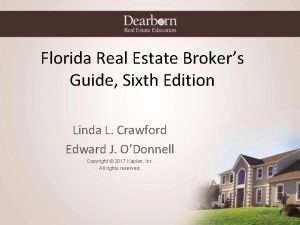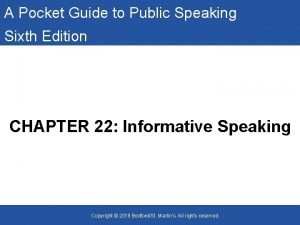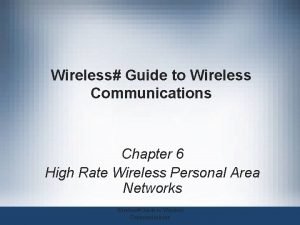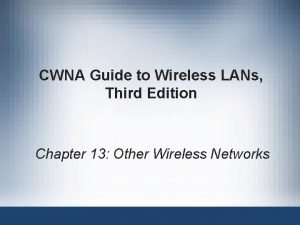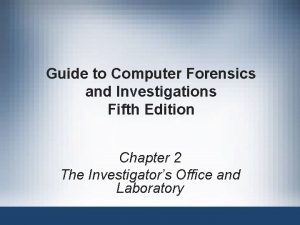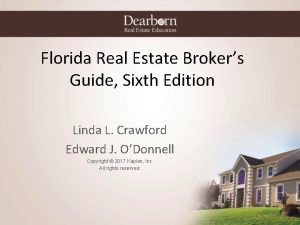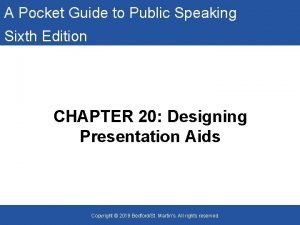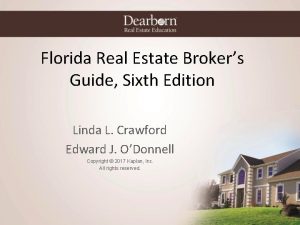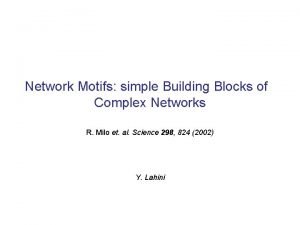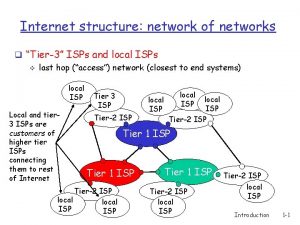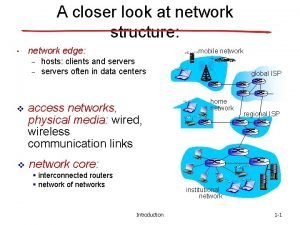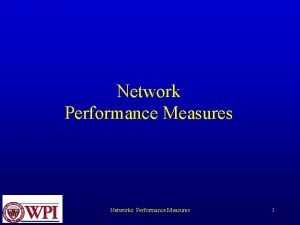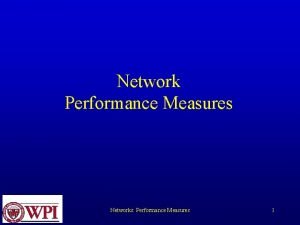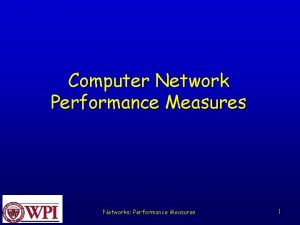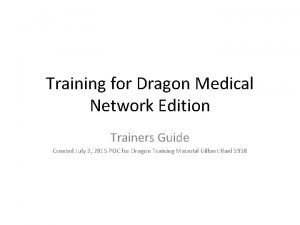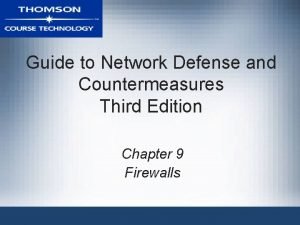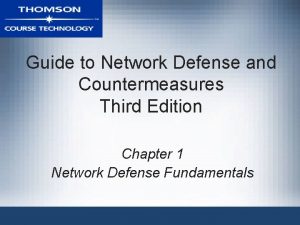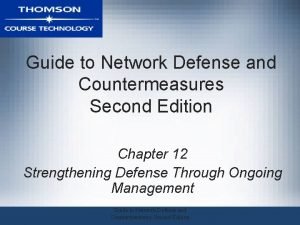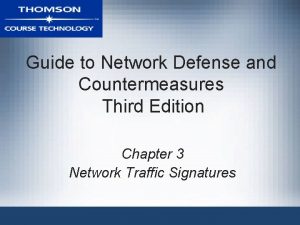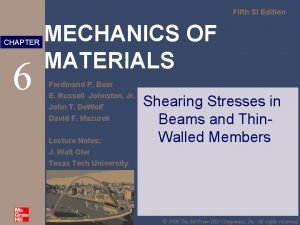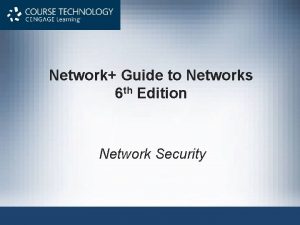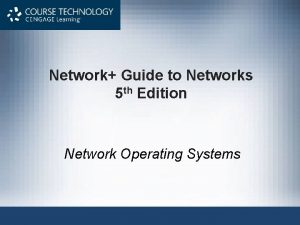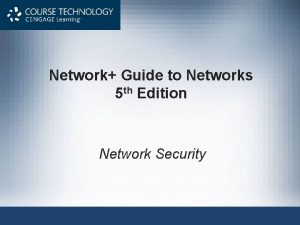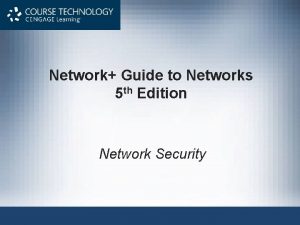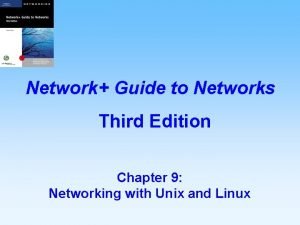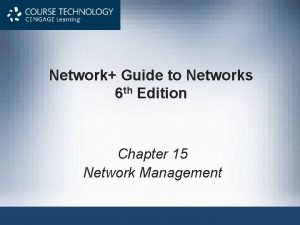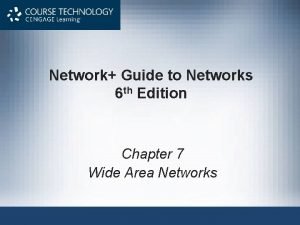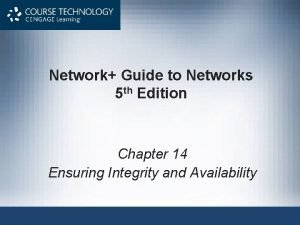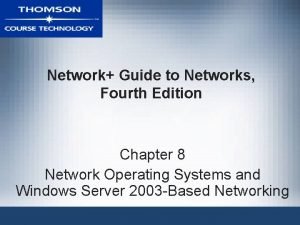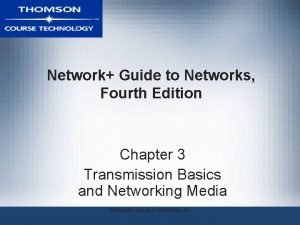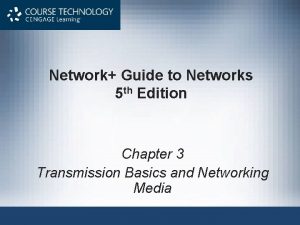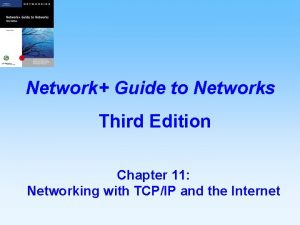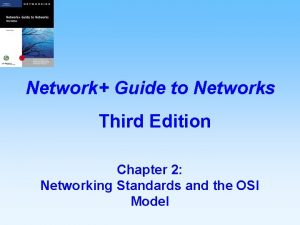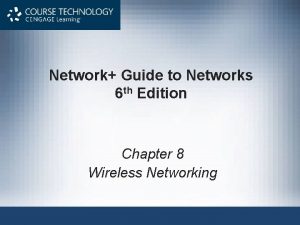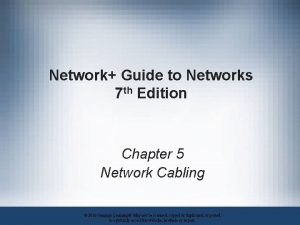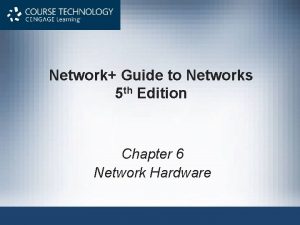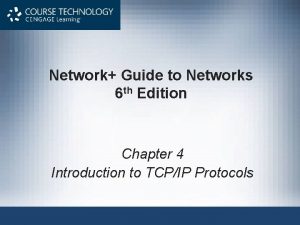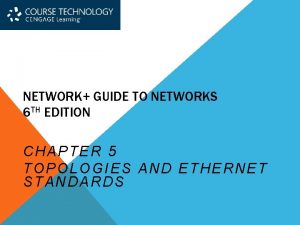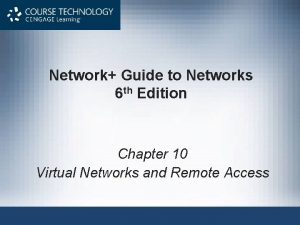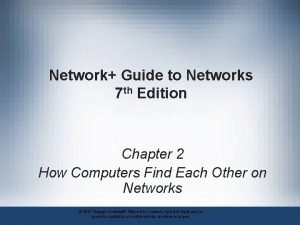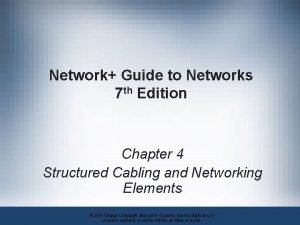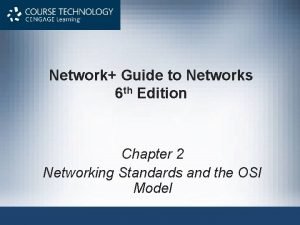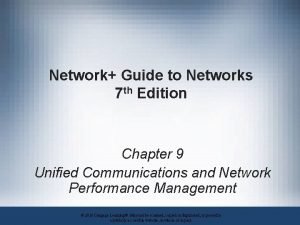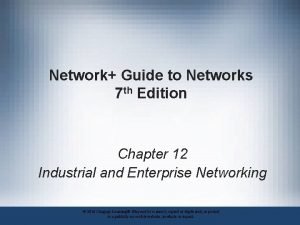NETWORK GUIDE TO NETWORKS TH 6 EDITION Chapter

























































- Slides: 57

NETWORK+ GUIDE TO NETWORKS TH 6 EDITION Chapter 3 Transmission Basics and Networking Media

Network+ Guide to Networks, 6 th Edition 2 Objectives • Explain basic data transmission concepts, including full duplexing, attenuation, latency, and noise • Describe the physical characteristics of coaxial cable, STP, UTP, and fiber-optic media • Compare the benefits and limitations of different networking media • Explain the principles behind and uses for serial cables • Identify wiring standards and the best practices for cabling buildings and work areas

Network+ Guide to Networks, 6 th Edition Transmission Basics • Transmit • Issue signals along network medium • Transmission • Process of transmitting • Signal progress after transmitting • Transceiver • Transmits and receives signals 3

Network+ Guide to Networks, 6 th Edition Analog and Digital Signaling • Important data transmission characteristic • Signaling type: analog or digital • Volt • Electrical current pressure • Electrical signal strength • Directly proportional to voltage • Signals • Current, light pulses, electromagnetic waves 4

Network+ Guide to Networks, 6 th Edition 5 Analog and Digital Signaling (cont’d. ) • Analog data signals • Voltage varies continuously • Fundamental properties of analog signals • Amplitude • Measure of strength at given point in time • Frequency • Number of times amplitude cycles over fixed time • Wavelength • Distance between one peak and the next • Phase • Progress of wave over time compared to a fixed point

Network+ Guide to Networks, 6 th Edition Figure 3 -1 An example of an analog signal Courtesy Course Technology/Cengage Learning 6

Network+ Guide to Networks, 6 th Edition 7 Analog and Digital Signaling (cont’d. ) • Analog signal benefit over digital • More variable • Convey greater subtleties with less energy • Drawback of analog signals • Varied and imprecise voltage • Susceptible to transmission flaws • Digital signals • Pulses of voltages • Positive voltage represents a 1 • Zero voltage represents a 0

Network+ Guide to Networks, 6 th Edition 8

Network+ Guide to Networks, 6 th Edition 9 Analog and Digital Signaling (cont’d. ) • Digital signal benefit over analog signal • More reliable • Less severe noise interference • Digital signal drawback • Many pulses required to transmit same information • Overhead • Nondata information • Required for proper signal routing and interpretation • Example: network layer addressing information

Network+ Guide to Networks, 6 th Edition 10 Data Modulation • Data relies on digital transmission • Network connection may handle only analog signals • Modem • Accomplishes translation • Modulator (analog to digital) • Demodulator (digital to analog) • Data modulation • Technology modifying analog signals • Make data suitable for carrying over communication path

Network+ Guide to Networks, 6 th Edition 11 Simplex, Half-Duplex, and Duplex • Simplex • Signals travel in one direction • Half-duplex transmission • Signals travel in both directions • One at a time • Shared communication channel • Full-duplex • Signals travel in both directions simultaneously • Used on data networks

Network+ Guide to Networks, 6 th Edition Multiplexing • Multiple signals • Travel simultaneously over one medium • Subchannels • Logical multiple smaller channels • Multiplexer (mux) • Combines many channel signals • Demultiplexer (demux) • Separates combined signals • Regenerates them 12

Network+ Guide to Networks, 6 th Edition Multiplexing (cont’d. ) • Time division multiplexing (TDM) - telephony • Divides channel into multiple time intervals Figure 3 -7 Time division multiplexing Courtesy Course Technology/Cengage Learning 13

Network+ Guide to Networks, 6 th Edition 14 Multiplexing (cont’d. ) • Frequency division multiplexing (FDM) – cable TV • Unique frequency band for each communications subchannel • Cellular telephone transmission • DSL Internet access Figure 3 -9 Frequency division multiplexing Courtesy Course Technology/Cengage Learning

Network+ Guide to Networks, 6 th Edition Multiplexing (cont’d. ) • Wavelength division multiplexing (WDM) • One fiber-optic connection • Carries multiple light signals simultaneously Figure 3 -10 Wavelength division multiplexing Courtesy Course Technology/Cengage Learning 15

Network+ Guide to Networks, 6 th Edition Relationships Between Nodes • Point-to-point transmission • One transmitter and one receiver • Point-to-multipoint transmission • One transmitter and multiple receivers • Broadcast transmission • One transmitter and multiple, undefined receivers • Used on wired and wireless networks • Simple and quick • Nonbroadcast • One transmitter and multiple, defined recipients 16

Network+ Guide to Networks, 6 th Edition Figure 3 -11 Point-to-point versus broadcast transmission Courtesy Course Technology/Cengage Learning 17

Network+ Guide to Networks, 6 th Edition 18 Throughput and Bandwidth • Throughput • Amount of data transmitted during given time period • Also called capacity or bandwidth • Expressed as bits transmitted per second • Bandwidth (strict definition) • Difference between highest and lowest frequencies medium can transmit • Range of frequencies • Measured in hertz (Hz)

Network+ Guide to Networks, 6 th Edition Table 3 -1 Throughput measures Courtesy Course Technology/Cengage Learning 19

Network+ Guide to Networks, 6 th Edition 20 Baseband Broadband • Baseband transmission • Digital signals sent through direct current (DC) pulses applied to wire • Requires exclusive use of wire’s capacity • Transmit one signal (channel) at a time • Example: Ethernet • Broadband transmission • Signals modulated as radio frequency (RF) analog waves • Uses different frequency ranges • Does not encode information as digital pulses

Network+ Guide to Networks, 6 th Edition Transmission Flaws • Noise • Any undesirable influence degrading or distorting signal • Types of noise • EMI (electromagnetic interference) • Example: radio frequency interference • Cross talk • Signal on one wire infringes on adjacent wire signal • Near end cross talk (NEXT) occurs near source 21

Network+ Guide to Networks, 6 th Edition Figure 3 -12 Cross talk between wires in a cable Courtesy Course Technology/Cengage Learning 22

Network+ Guide to Networks, 6 th Edition Transmission Flaws (cont’d. ) • Attenuation • Loss of signal’s strength as it travels away from source • Signal boosting technology • Analog signals pass through amplifier • Noise also amplified • Regeneration • Digital signals retransmitted in original form • Repeater: device regenerating digital signals • Amplifiers and repeaters • OSI model Physical layer 23

Network+ Guide to Networks, 6 th Edition 24

Network+ Guide to Networks, 6 th Edition 25 Transmission Flaws (cont’d. ) • Latency • Delay between signal transmission and receipt • May cause network transmission errors • Latency causes • Cable length • Intervening connectivity device • Round trip time (RTT) • Time for packet to go from sender to receiver, then back from receiver to sender

Network+ Guide to Networks, 6 th Edition Common Media Characteristics • Selecting transmission media • Match networking needs with media characteristics • Physical media characteristics • Throughput • Cost • Noise immunity • Size and scalability • Connectors and media converters 26

Network+ Guide to Networks, 6 th Edition 27 Throughput • Most significant factor in choosing transmission method • Causes of throughput limitations • Laws of physics • Signaling and multiplexing techniques • Noise • Devices connected to transmission medium • Fiber-optic cables allow faster throughput • Compared to copper or wireless connections

Network+ Guide to Networks, 6 th Edition Cost • Precise costs difficult to pinpoint • Media cost dependencies • Existing hardware, network size, labor costs • Variables influencing final cost • Installation cost • New infrastructure cost versus reuse • Maintenance and support costs • Cost of lower transmission rate affecting productivity • Cost of downtime • Cost of obsolescence 28

Network+ Guide to Networks, 6 th Edition Noise Immunity • Noise distorts data signals • Distortion rate dependent upon transmission media • Fiber-optic: least susceptible to noise • Limit noise impact on network • Cable installation • Far away from powerful electromagnetic forces • Select media protecting signal from noise • Antinoise algorithms 29

Network+ Guide to Networks, 6 th Edition Size and Scalability • Three specifications • Maximum nodes per segment • Maximum segment length • Maximum network length • Maximum nodes per segment dependency • Attenuation and latency • Maximum segment length dependency • Attenuation and latency plus segment type 30

Network+ Guide to Networks, 6 th Edition Size and Scalability (cont’d. ) • Segment types • Populated: contains end nodes • Unpopulated: no end nodes • Also called link segment • Segment length limitation • After certain distance, signal loses strength • Cannot be accurately interpreted 31

Network+ Guide to Networks, 6 th Edition 32 Connectors and Media Converters • Connectors • Hardware connecting wire to network device • Specific to particular media type • Affect costs • Installing and maintaining network • Ease of adding new segments or nodes • Technical expertise required to maintain network • Media converter • Hardware enabling networks or segments running on different media to interconnect and exchange signals

Network+ Guide to Networks, 6 th Edition Figure 3 -15 Copper wire-to-fiber media converter Courtesy of Omnitron Systems Technology 33

Network+ Guide to Networks, 6 th Edition Coaxial Cable • Central metal core (often copper) surrounded by: • Insulator • Braided metal shielding (braiding or shield) • Outer cover (sheath or jacket) Figure 3 -16 Coaxial cable Courtesy Course Technology/Cengage Learning 34

Network+ Guide to Networks, 6 th Edition Coaxial Cable (cont’d. ) • High noise resistance • Advantage over twisted pair cabling • Carry signals farther before amplifier required • Disadvantage over twisted pair cabling • More expensive • Hundreds of specifications • RG specification number • Differences: shielding and conducting cores • Transmission characteristics 35

Network+ Guide to Networks, 6 th Edition 36 Figure 3 -17 F-Type connector Figure 3 -18 BNC connector Courtesy of MCM Electronics, Inc. © Igor Smichkov/Shutterstock. com

Network+ Guide to Networks, 6 th Edition Twisted Pair Cable • Color-coded insulated copper wire pairs • 0. 4 to 0. 8 mm diameter • Encased in a plastic sheath Figure 3 -19 Twisted pair cable Courtesy Course Technology/Cengage Learning 37

Network+ Guide to Networks, 6 th Edition Twisted Pair Cable (cont’d. ) • More wire pair twists per foot • More resistance to cross talk • Higher-quality • More expensive • Twist ratio • Twists per meter or foot • High twist ratio • Greater attenuation 38

Network+ Guide to Networks, 6 th Edition 39 Twisted Pair Cable (cont’d. ) • Hundreds of different designs • Twist ratio, number of wire pairs, copper grade, shielding type, shielding materials • 1 to 4200 wire pairs possible • Wiring standard specification • TIA/EIA 568 • Most common twisted pair types • Category (cat) 3, 5, 5 e, 6, 6 a, 7 • CAT 5 or higher used in modern LANs

Network+ Guide to Networks, 6 th Edition Twisted Pair Cable (cont’d. ) • Advantages • Relatively inexpensive • Flexible • Easy installation • Spans significant distance before requiring repeater • Accommodates several different topologies • Two categories • Shielded twisted pair (STP) • Unshielded twisted pair (UTP) 40

Network+ Guide to Networks, 6 th Edition STP (Shielded Twisted Pair) • Individually insulated • Surrounded by metallic substance shielding (foil) • Barrier to external electromagnetic forces • Contains electrical energy of signals inside • May be grounded Figure 3 -20 STP cable Courtesy Course Technology/Cengage Learning 41

Network+ Guide to Networks, 6 th Edition UTP (Unshielded Twisted Pair) • One or more insulated wire pairs • Encased in plastic sheath • No additional shielding • Less expensive, less noise resistance Figure 3 -21 UTP cable Courtesy Course Technology/Cengage Learning 42

Network+ Guide to Networks, 6 th Edition Comparing STP and UTP • Throughput • STP and UTP can transmit the same rates • Cost • STP and UTP vary • Connector • STP and UTP use Registered Jack 45 • Telephone connections use Registered Jack 11 43

Network+ Guide to Networks, 6 th Edition 44 Comparing STP and UTP (cont’d. ) • Noise immunity • STP more noise resistant • Size and scalability • Maximum segment length for both: 100 meters

Network+ Guide to Networks, 6 th Edition Terminating Twisted Pair Cable • Patch cable • Relatively short cable • Connectors at both ends • Proper cable termination techniques • Basic requirement for two nodes to communicate • Poor terminations: • Lead to loss or noise • TIA/EIA standards • TIA/EIA 568 A • TIA/EIA 568 B 45

Network+ Guide to Networks, 6 th Edition 46 Figure 3 -24 TIA/EIA 568 A standard terminations Figure 3 -25 TIA/EIA 568 B standard terminations Courtesy Course Technology/Cengage Learning

Network+ Guide to Networks, 6 th Edition 47 Terminating Twisted Pair Cable (cont’d. ) • Straight-through cable • Terminate RJ-45 plugs at both ends identically • Crossover cable • Transmit and receive wires on one end reversed Figure 3 -26 RJ-45 terminations on a crossover cable Courtesy Course Technology/Cengage Learning

Network+ Guide to Networks, 6 th Edition 48 Fiber-Optic Cable • Fiber-optic cable (fiber) • One or more glass or plastic fibers at its center (core) • Data transmission • Pulsing light sent from laser or light-emitting diode (LED) through central fibers • Cladding • Layer of glass or plastic surrounding fibers • Different density from glass or plastic in strands • Reflects light back to core • Allows fiber to bend

Network+ Guide to Networks, 6 th Edition Fiber-Optic Cable (cont’d. ) • Plastic buffer outside cladding • Protects cladding and core • Opaque to absorb escaping light • Surrounded by Kevlar (polymeric fiber) strands • Plastic sheath covers Kevlar strands Figure 3 -30 A fiber-optic cable Courtesy of Optical Cable Corporation 49

Network+ Guide to Networks, 6 th Edition Fiber-Optic Cable (cont’d. ) • Benefits over copper cabling • Extremely high throughput • Very high noise resistance • Excellent security • Able to carry signals for longer distances • Industry standard for high-speed networking • Drawbacks • More expensive than twisted pair cable • Requires special equipment to splice 50

Network+ Guide to Networks, 6 th Edition SMF (Single-Mode Fiber) • Consists of narrow core (8 -10 microns in diameter) • Laser-generated light travels over one path • Little reflection • Light does not disperse as signal travels • Can carry signals many miles: • Before repeating required • Rarely used for shorter connections • Due to cost 51

Network+ Guide to Networks, 6 th Edition 52 MMF (Multimode Fiber) • Contains core with larger diameter than single-mode fiber • Common sizes: 50 or 62. 5 microns • Laser or LED generated light pulses travel at different angles • Greater attenuation than single-mode fiber • Common uses • Cables connecting router to a switch • Cables connecting server on network backbone

Network+ Guide to Networks, 6 th Edition Figure 3 -42 TIA/EIA structured cabling in an enterprise Courtesy Course Technology/Cengage Learning 53

Network+ Guide to Networks, 6 th Edition Structured Cabling (cont’d. ) Table 3 -2 TIA/EIA specifications for backbone cabling Courtesy Course Technology/Cengage Learning 54

Network+ Guide to Networks, 6 th Edition 55 Summary • Information transmission methods • Analog • Digital • Multiplexing allows multiple signals to travel simultaneously over one medium • Full and half-duplex specifies whether signals can travel in both directions or one direction at a time • Noise distorts both analog and digital signals • Attenuation • Loss of signal as it travels

Network+ Guide to Networks, 6 th Edition 56 Summary (cont’d. ) • Coaxial cable composed of core, insulator, shielding, sheath • Types of twisted pair cable • Shielded and unshielded • Fiber-optic cable transmits data through light passing through the central fibers

Network+ Guide to Networks, 6 th Edition 57 Summary (cont’d. ) • Fiber-optic cable categories • Single and multimode fiber • Serial communication often used for short connections between devices • Structured cabling standard provides wiring guidelines
 Virtual circuit vs datagram
Virtual circuit vs datagram Backbone networks in computer networks
Backbone networks in computer networks Neural networks and learning machines 3rd edition
Neural networks and learning machines 3rd edition Using mis (10th edition) 10th edition
Using mis (10th edition) 10th edition Chapter 1
Chapter 1 Florida real estate broker's guide 6th edition
Florida real estate broker's guide 6th edition Florida real estate broker's guide 6th edition
Florida real estate broker's guide 6th edition Pocket guide to public speaking
Pocket guide to public speaking Guide to wireless communications
Guide to wireless communications Marking bad clusters data hiding technique
Marking bad clusters data hiding technique Prehospital emergency care 11th edition
Prehospital emergency care 11th edition Florida real estate broker's guide 6th edition
Florida real estate broker's guide 6th edition Florida real estate broker's guide 6th edition
Florida real estate broker's guide 6th edition Cwna guide to wireless lans 3rd edition
Cwna guide to wireless lans 3rd edition Digital forensic lab floor plan
Digital forensic lab floor plan Florida real estate broker's guide
Florida real estate broker's guide A pocket guide to public speaking 6th edition
A pocket guide to public speaking 6th edition A pocket guide to public speaking 6th edition
A pocket guide to public speaking 6th edition Dk guide to public speaking 2nd edition
Dk guide to public speaking 2nd edition Florida real estate broker's guide 6th edition
Florida real estate broker's guide 6th edition Florida real estate broker's guide 6th edition
Florida real estate broker's guide 6th edition Florida real estate broker's guide 6th edition
Florida real estate broker's guide 6th edition Palo alto networks certified network security engineer
Palo alto networks certified network security engineer Principles of network applications in computer networks
Principles of network applications in computer networks Network motifs: simple building blocks of complex networks
Network motifs: simple building blocks of complex networks The network layer is concerned with
The network layer is concerned with Tier 3 isp
Tier 3 isp Internet structure network of networks
Internet structure network of networks Network layer design issues
Network layer design issues Network performance measurement in computer networks
Network performance measurement in computer networks Network performance measures
Network performance measures Performance metrics in computer networks
Performance metrics in computer networks William stallings network security essentials 5th edition
William stallings network security essentials 5th edition Modulo table
Modulo table Dragon medical tutorials
Dragon medical tutorials Cryptography and network security 6th edition pdf
Cryptography and network security 6th edition pdf Cryptography and network security 4th edition
Cryptography and network security 4th edition Network security essentials 5th edition
Network security essentials 5th edition Cryptography and network security 7th edition
Cryptography and network security 7th edition Security guide to network security fundamentals
Security guide to network security fundamentals Guide to network defense and countermeasures
Guide to network defense and countermeasures Guide to network defense and countermeasures
Guide to network defense and countermeasures Information rules a strategic guide to the network economy
Information rules a strategic guide to the network economy Operational auditing
Operational auditing Whirshark
Whirshark Security guide to network security fundamentals
Security guide to network security fundamentals Security guide to network security fundamentals
Security guide to network security fundamentals Network topology in computer network
Network topology in computer network Features of peer to peer network and client server network
Features of peer to peer network and client server network Ece 526
Ece 526 Network centric computing and network centric content
Network centric computing and network centric content Advantages and disadvantages of circuit switching
Advantages and disadvantages of circuit switching Organizational behavior 18th edition chapter 1
Organizational behavior 18th edition chapter 1 Thermodynamic vs kinetic control
Thermodynamic vs kinetic control Mechanics of materials chapter 10 solutions
Mechanics of materials chapter 10 solutions Chapter 7 beer
Chapter 7 beer Mechanics of materials 7th edition solutions chapter 6
Mechanics of materials 7th edition solutions chapter 6 Mechanics
Mechanics






